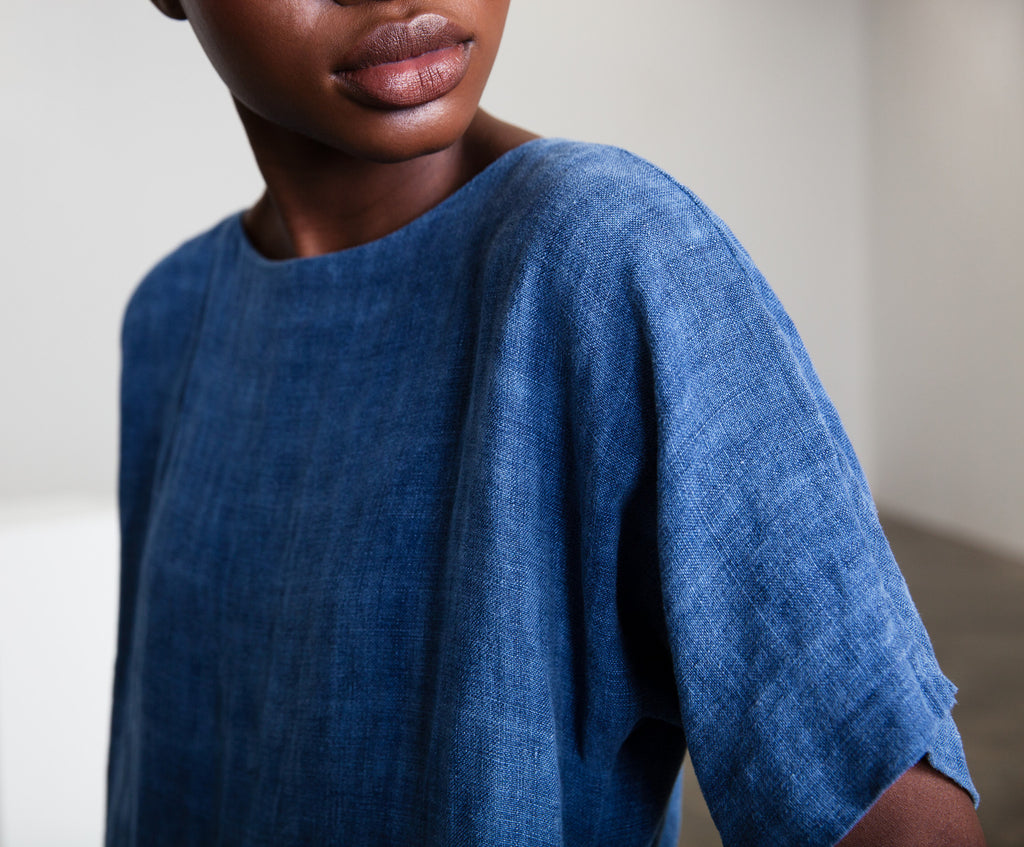

At blluemade we're proud to source the world's finest quality Belgian linen to make our garments. We fell in love with linen before we knew much about it, and over the past year have enjoyed learning more about this unique textile.
Linen comes from the flax plant, which has wonderful sustainability aspects. Linen accounts for a mere 1% of global textile consumption. The flax plant takes much less water, energy, and pesticides to grow than cotton, and uses far less resources than polyester. In addition, the family-run mill we work with has been CO2 neutral for several years.The environmental impact of spinning and weaving linen is very minimal, and every aspect of the plant is used. Flax seeds can be eaten, or pressed into linseed oil. Stray fibers from the spinning and weaving process are collected and used to create processes. 25% of each American dollar comprises linen fibers.
flax: growth and harvest
The harvesting period for flax occurs mid-summer. Each plant blooms for one day only, in shades of blue and white, making the blooming field a truly spectacular sight. Afterwards, the mill we work with pulls the plant down to the root. Pulling the plant, rather than cutting, means every strand of fiber in the finished product is particularly long, strong, and soft.
After the harvest, the plant is spread in the field in the field to dry. Flax fibers that eventually become fabric are bound to the woody plant stems by natural pectins and must be "ret" in order to naturally separate. Traditionally, this happens in streams and rivers, but the company we work with has figured out a low-water-use way to ret their line, using only dew and rain. Dew, rain, and sunshine work in tandem to dissolve the pectins and loosen the fibers. It turns out, as with the New York bagel, there's something in the water in Ireland and Belgium that leads to the longest flax fibers and the most effective retting process. After a few weeks, an expert determines the flax is ready to be harvested for its fiber.

linen production:
The retted flax plants are tied together into large bales and is ready for processing. Flax seeds are removed to be eaten or saved to replant in the future. Large rollers separate the fiber from the woody part of the stem and the fibers are sorted based on size. Quality is assessed, and the finest fibers move on for fabric production, while other fibers are designated for rougher textiles.

The highest-grade flax fibers are combed in order to create long uniform lines of thread. Then it is spun into yarn. Yarn is checked for tensile strength and smoothness and then moves on to the weaving process. The yarn is woven into fabric on machines operated by experts who check the process throughout. A mender inspects the loomstate fabric, which is fabric in its unfinished state, for protruding loops, and corrects flaws by hand.

Finally, the linen fabric is sheared to remove any fabric pills or imperfections. The waste at all points of the weaving process is collected and recycled for paper and insulation production. The fabric then undergoes treatments such as washing, dyeing, and bleaching in order to achieve the desired color, texture, and finish.
The steps taken throughout the process ensure the linen fabric is soft, strong, and flawless. We are thrilled to use this high-quality Belgian linen to make our products, and know you'll feel the difference. Our linen comes with the Belgian Masters of Linen certification, which asserts that from flax seed to finished bolt of cloth, every step of the process towards making our linen happens in Belgium. The importance of this cannot be emphasized enough. Today, there are producers in other countries who will buy flax seeds from Belgium, grow and process the fiber elsewhere, and call this product Belgian linen. Due to the particularities of Belgium's soil, climate, and water, however, flax grown elsewhere will not have the long fibers and strength of true Belgian linen. There's also counterfeit linen product on the market called ramie, which is a natural product which appears like linen, but does not have the longevity, softness, or strength of the true linen product.
When we began sourcing linen fabric for blluemade, we ordered swatches from all over the world. The Belgian linen we received in the mail was such a beautiful, impressive product that we felt we'd be doing our customers a disservice if we used anything else. We are proud to use Belgian linen to make blluemade garments and accessories, and know you'll feel the difference when you wear and use our products.

--All flax and linen production images courtesy of the Libeco company. All indigo garment pictures courtesy of blluemade.
